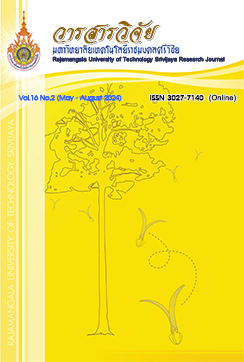In Vitro Selection of Salt Tolerant in 4 Vetiver Ecotypes
Keywords:
vetiver, plant tissue culture, salt tolerance, selectionAbstract
Reducing salinity of soil surface with a bio-technical method can be conducted by planting plants with deep root systems to protect salt-containing underground water from moving up to the soil surface. Vetiver (Chrysopogon zizanioides (L.) Roberty) is the grass that has deep root systems and has ability to maintain soil moisture. Therefore, this study aimed to investigate the salt tolerance ability of the vetiver ecotype in order to identify ecotypes that can be grown in saline land. The four ecotypes of vetiver, namely Surat Thani (SU): Ratchaburi (RB), Mai-Huaiwai (MHW), and Songkhla 3 (SK), were used in this experiment. The in vitro plantlets (shoot and root) were cultured on semi-solid Murashige and Skoog (MS) medium supplemented with 0 (5.4 dS/m) 1 (13.2 dS/m), 2 (35.7 dS/m), and 3 (53.5 dS/m) NaCl for 8 weeks. The results showed that increasing NaCl concentrations resulted in lower survival percentage, shoot length, root length, fresh and dry weight of the root, fresh and dry weight of fresh leaves, and fresh and dry weight of the dead leaves for all four vetiver ecotypes. However, survival percentages of SU under NaCl conditions were not significantly different from that of the control, while other vetiver ecotypes showed a significant decrease in survival rate under NaCl condition. In addition, fresh weight of fresh leaves and dead leaves of SU under NaCl conditions was higher than that of control. Tiller number of SU, RB and MHW were increased after cultured on 1% NaCl treatment. From the results, therefore, SU showed better salt tolerance performance than other vetiver ecotypes under in vitro conditions.
References
Athar, H.R. and Ashraf, M. 2009. Strategies for crop improvement against salinity and drought stress: An overview, pp. 1-16. In Ashraf, M, Ozturk, M. and Athar, H.R., eds. Salinity and Water Stress: Improving Crop Efficiency. Springer, New York.
Botella, M.A., Rosado, A., Bressan R.A. and Hasegawa, P.M. 2005. Plant adaptive responses to salinity stress, pp. 37-70. In Jenks, M.A. and Hasegawa, P.M., eds. Plant Abiotic Stress. Blackwell Publishing Ltd., Oxford.
Chaisena, Y. 2014. Research and Development on Vetiver Grass Utilization for Highland Communities; A Case Study of Mae Hae Royal Project, Chiang Mai Province. Master of Science in Geosocial Based Sustainable Development, Maejo University.
Edelstein, M., Plaut, Z., Dudai, N. and Ben-Hur, M. 2009. Vetiver (Vetiveria zizanioides) responses to fertilization and salinity under irrigation conditions. Journal of Environmental Management 91(1): 215-221.
Liu, W.G., Liu, J.X., Yao, M.L. and Ma, Q.F. 2016. Salt tolerance of a wild ecotype of vetiver grass (Vetiveria zizanioides L.) in southern China. Botanical Studies 57(1): 27-34.
Maikami, M., Kaveeta, L., Peyachoknagul, S. and Nanakorn, M. 2017. In vitro tetraploid induction of Chrysopogon zizanioides (L.) Roberty to improve salt tolerance. Thai Agricultural Research Journal 35(1): 31-48.
Munns, R. 2002. Comparative physiology of salt and water stress. Plant, Cell & Environment 25(2): 239-250.
Munns, R., James, R.A., Gilliham, M., Flowers, T.J. and Colmer, T.D. 2016. Tissue tolerance: an essential but elusive trait for salt-tolerant crops. Functional Plant Biology 43(12): 1103-1113.
Murashige, T. and Skoog, F. 1962. A revised medium for rapid growth and bioassays with tobacco tissue cultures. Physiologia Plantarum 15(3): 473-497.
Nakhoda, B., Leung, H., Mendioro, M.S., Mohammadi-nejad, G. and Ismail, A.M. 2012. Isolation, characterization, and field evaluation of rice (Oryza sativa L., Var. IR64) mutants with altered responses to salt stress. Field Crops Research 127: 191-202.
Nanakorn, M., Surawattananon, S., Wongwattana, C., Namwongporm, K. and Suwannachitr, S. 1998. In vitro induction of salt tolerance in vetiver grass (Vetiveria zizanioides Nash). Journal of Weed Science and Technology 43(2): 134-137.
Office of the Royal Development Projects Board. 2012. Guide to Managing Saline Soil for Rice Cultivation, Phu Phan Royal Development Study Centre under the Royal Initiative. Movement Gen 3 Co., Ltd., Bangkok.
Prathomjinda, Y., Srinives, P. and Thiraporn, R. 1995. Effect of shading and soil salinity on growth of native vetiver grasses. Kasetsart Journal (Natural Sciences) 29(2): 143-149. (in Thai)
Silva, E.D., Ribeiro, R.V., Ferreira-Silva, S.L., Viégas, R.A. and Silveira, J.A.G. 2010. Comparative effects of salinity and water stress on photosynthesis, water relations and growth of Jatropha curcas plants. Journal of Arid Environments 74(10): 1130-1137.
Suwannachitr, S. 1997. In Vitro Screening and Selection for Salt Tolerance in Vetiver Grass. Master of Science, Kasetsart University, Bangkok. (in Thai)
Taejajai, U. and Thampanyo, N. 2014. Study on the Selection of Vetiver Grass Ecotypes under Shading Environment. Journal of Soil and Water Conservation (Thailand) 29(2): 7-17.
Downloads
Published
How to Cite
Issue
Section
License
Copyright (c) 2024 Rajamangala University of Technology Srivijaya Research Journal

This work is licensed under a Creative Commons Attribution-NonCommercial-NoDerivatives 4.0 International License.
The content and information in the article published in Journal of Rajamangala University of Technology Srivijaya It is the opinion and responsibility of the author of the article. The editorial journals do not need to agree. Or share any responsibility.







